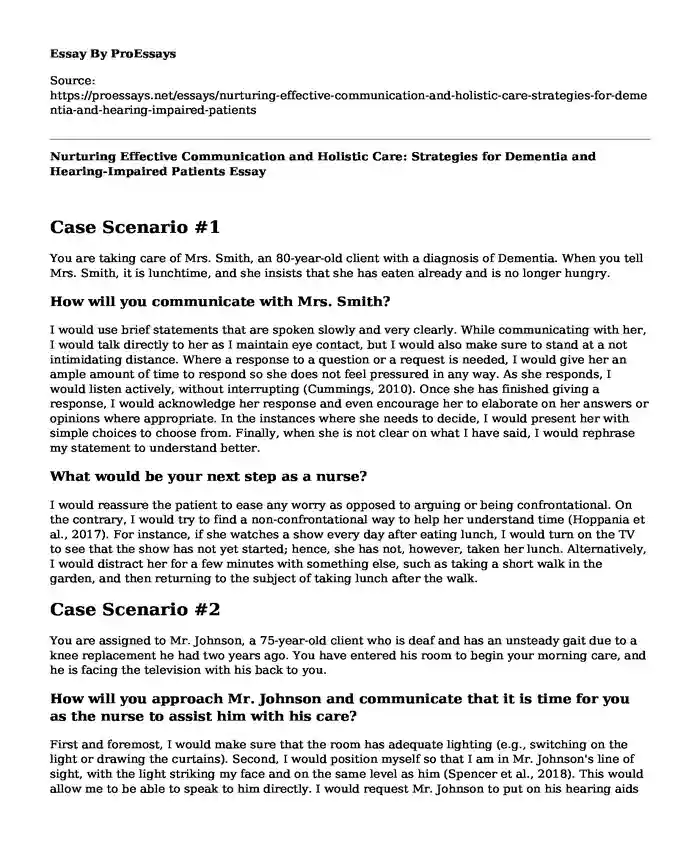Case Scenario #1
You are taking care of Mrs. Smith, an 80-year-old client with a diagnosis of Dementia. When you tell Mrs. Smith, it is lunchtime, and she insists that she has eaten already and is no longer hungry.
How will you communicate with Mrs. Smith?
I would use brief statements that are spoken slowly and very clearly. While communicating with her, I would talk directly to her as I maintain eye contact, but I would also make sure to stand at a not intimidating distance. Where a response to a question or a request is needed, I would give her an ample amount of time to respond so she does not feel pressured in any way. As she responds, I would listen actively, without interrupting (Cummings, 2010). Once she has finished giving a response, I would acknowledge her response and even encourage her to elaborate on her answers or opinions where appropriate. In the instances where she needs to decide, I would present her with simple choices to choose from. Finally, when she is not clear on what I have said, I would rephrase my statement to understand better.
What would be your next step as a nurse?
I would reassure the patient to ease any worry as opposed to arguing or being confrontational. On the contrary, I would try to find a non-confrontational way to help her understand time (Hoppania et al., 2017). For instance, if she watches a show every day after eating lunch, I would turn on the TV to see that the show has not yet started; hence, she has not, however, taken her lunch. Alternatively, I would distract her for a few minutes with something else, such as taking a short walk in the garden, and then returning to the subject of taking lunch after the walk.
Case Scenario #2
You are assigned to Mr. Johnson, a 75-year-old client who is deaf and has an unsteady gait due to a knee replacement he had two years ago. You have entered his room to begin your morning care, and he is facing the television with his back to you.
How will you approach Mr. Johnson and communicate that it is time for you as the nurse to assist him with his care?
First and foremost, I would make sure that the room has adequate lighting (e.g., switching on the light or drawing the curtains). Second, I would position myself so that I am in Mr. Johnson's line of sight, with the light striking my face and on the same level as him (Spencer et al., 2018). This would allow me to be able to speak to him directly. I would request Mr. Johnson to put on his hearing aids if he has any that he uses. Finally, I would communicate that it is time to assist him with his care routine (Spencer et al., 2018). While speaking with Mr. Johnson, I would make sure that I am not putting my hands to my face, and that I do not have anything that would alter my lips' movement as I speak. Some examples could be chewing gum or having an object such as a pen in my mouth, as these can interfere with Mr. Johnson's ability to read my lips as I speak (Spencer et al., 2018).
What nursing considerations and effective strategies when assisting the client in moving around as the client has an unsteady gait? (list at least two nursing considerations and two effective strategies)
The first consideration is to assess if the patient experiences any form of dizziness or lightheadedness (Baker, 2018). This could be due to anemia, vertigo, or even medications that cause orthostatic hypotension (such as anti-hypertensives). The most effective strategy for this consideration is first assisting the client in a sitting position (if he was lying down) for a few minutes. Then after that, ensuring that Mr. Johnson has the proper footwear (non-slip shoes) and that there is nothing slippery on the floor, bring the patient to a standing position and allow him to tolerate that position as well. The second consideration is if he has a weak side. The best strategy is to stand on Mr. Johnson's soft side as he moves around. Also, Mr. Johnson can be provided with the appropriate walking aids to support the weaker side.
References
Baker, J. M. (2018). Gait disorders. The American Journal of Medicine, 131(6), 602-607.
Cummings, L. (2020). Language in Dementia. Cambridge University Press.
Hoppania, H. K., Mäki-Petäjä-Leinonen, A., & Nikumaa, H. (2017). (Un) equal Treatment? Elderly care and disability services for people with Dementia in Finland. European Journal of Social Security, 19(3), 225-241.
Spencer, L. J., Marschark, M., Machmer, E., Durkin, A., Borgna, G., & Convertino, C. (2018). Communication skills of deaf and hard-of-hearing college students: Objective measures and self-assessment. Journal of Communication Disorders, 75, 13-24.
Cite this page
Nurturing Effective Communication and Holistic Care: Strategies for Dementia and Hearing-Impaired Patients. (2024, Jan 25). Retrieved from https://proessays.net/essays/nurturing-effective-communication-and-holistic-care-strategies-for-dementia-and-hearing-impaired-patients
If you are the original author of this essay and no longer wish to have it published on the ProEssays website, please click below to request its removal:
- Difference Between E-Cigarettes and Traditional Cigarettes Paper Example
- Teaching Students Who Is Hard of Hearing Paper Example
- Essay Example on Healthy Breakfast Options Emerging in American Market
- Essay Example on Military Moms: Sacrificing for Service & Family
- Paper Example on Include Dietary Fats for Body Energy, Cell Growth, Body Warmth & Nutrient Absorption
- Essay on COVID-19: Unprecedented Global Economic Impact and Life Changes in Houston
- Free Essay on Navigating the Opioid Crisis: Impacts, Responses, and Future Directions in America







